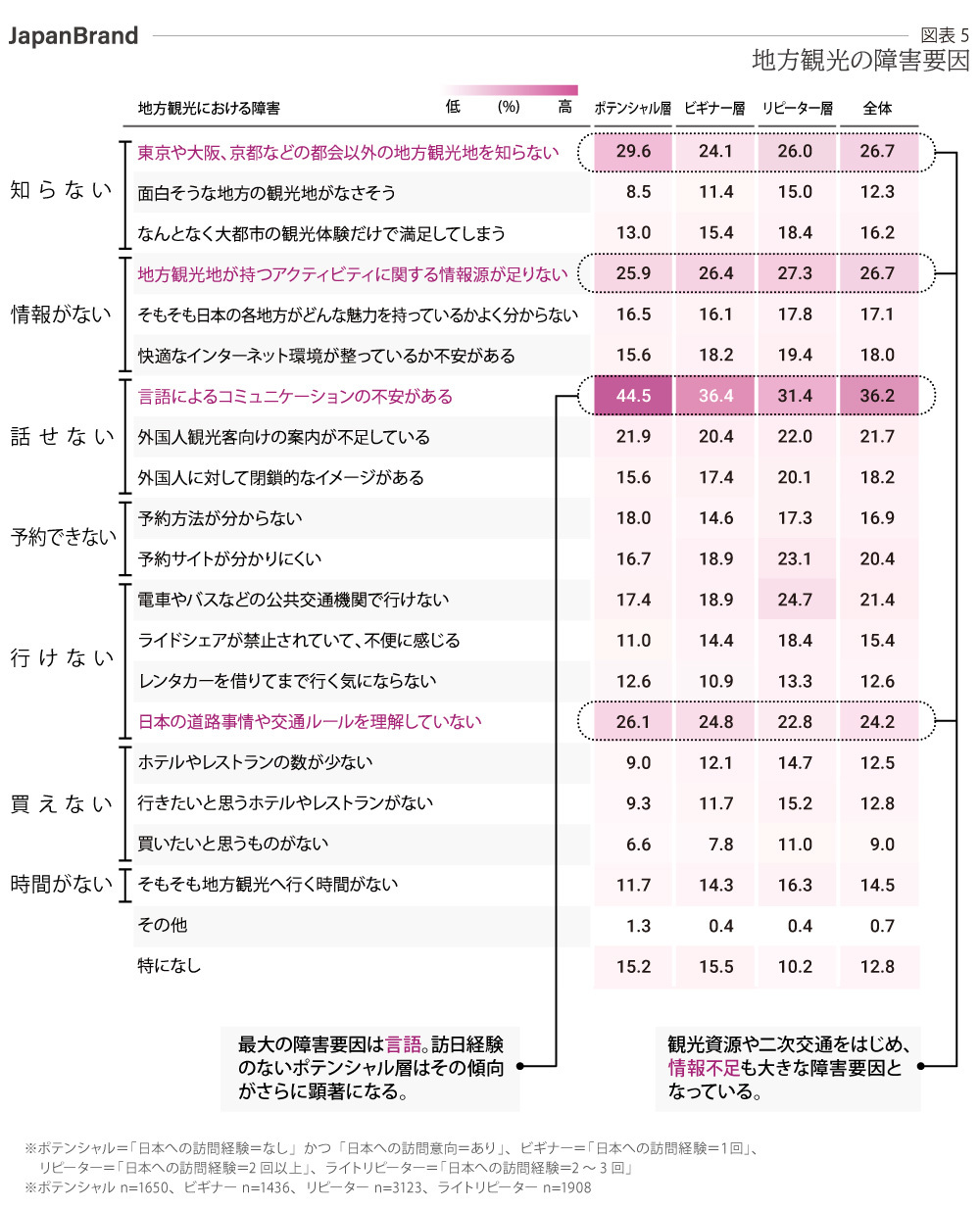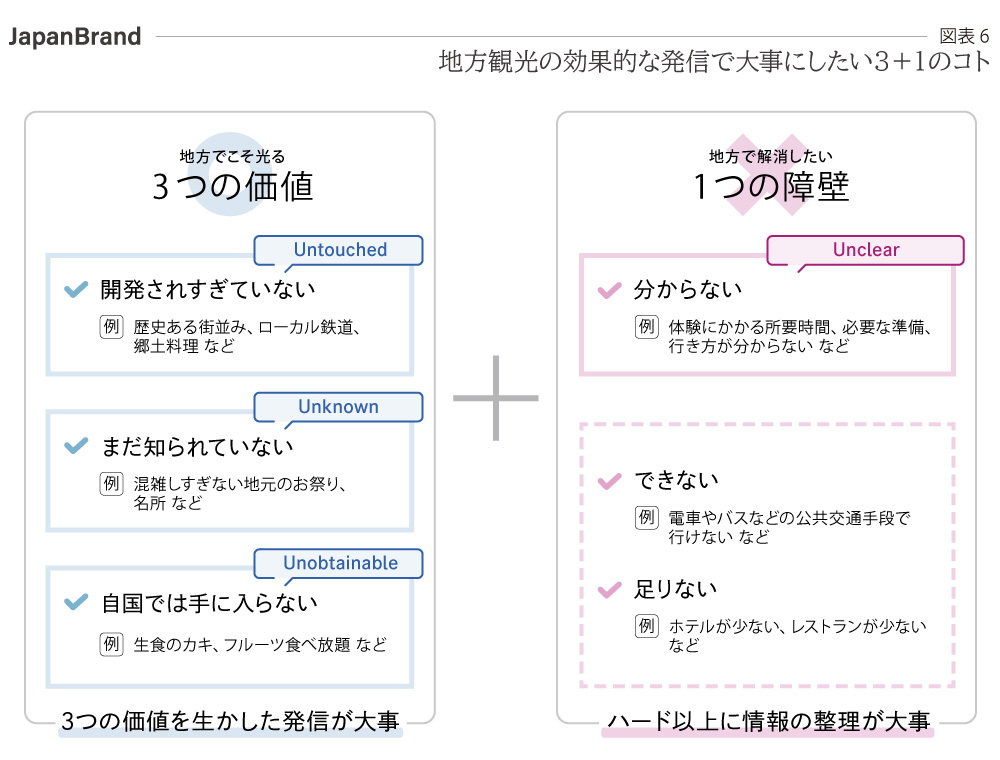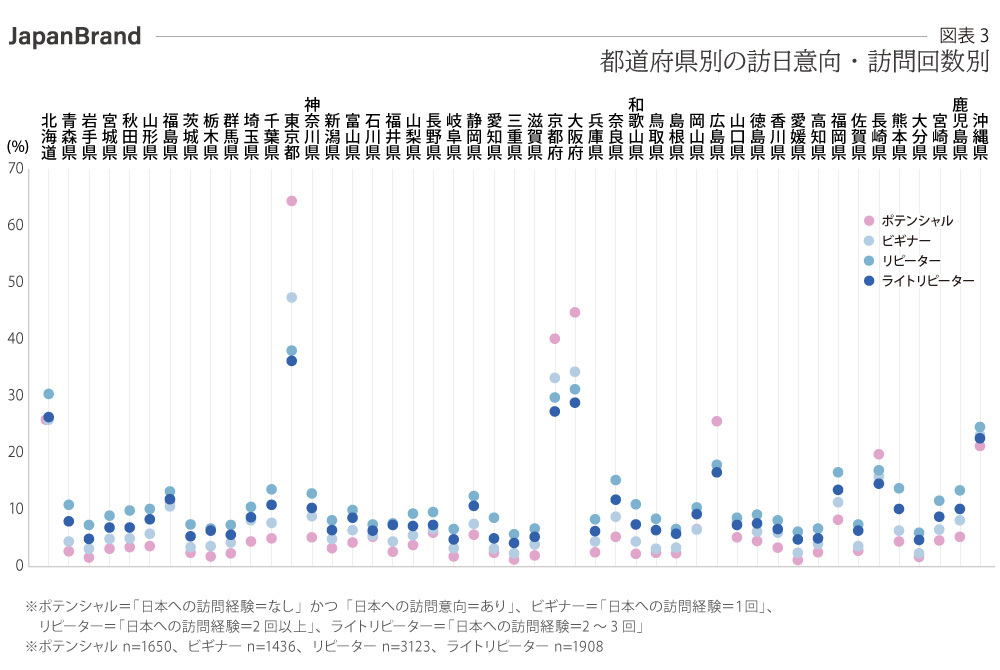Note: This website was automatically translated, so some terms or nuances may not be completely accurate.
What defines a Japan brand that shines in regional areas? 3+1 key strategies to attract international visitors to regional Japan.
Part 1 examined the current status of the "Japan Brand" based on the latest 2024 survey. Part 2 focused on "inbound tourism," tracing its evolution to its current popularity, including past surveys.
Part 3 shifts the focus to "Japan's Regions," examining specific points of interest in the increasingly popular "regional tourism" and the needs of visitors to Japan. We delve into the "Japan Brand that truly shines in the regions."
<Table of Contents>
▼Global Attention is Growing Toward "Regional Japan"
▼Approximately 68% of Visitors to Japan are Repeat Visitors. Opportunities to Attract Visitors Exist Nationwide!
▼Is the Absence of Something the Very Appeal!? Three "Absence" Values Expected in Regional Tourism
▼This is a No-Go! One "Absence" Obstacle to Overcome in Promoting Regional Tourism
▼Three + One Key Points to Prioritize in Promoting Regional Tourism
Global attention is growing toward "Japan's Regions"
The Japan Brand Survey continuously gathers data on "Awareness," "Visit Experience," and "Visit Intention" for Japan's 47 prefectures. Comparing the 2024 results with those from 2019, five years prior, confirms the rising recognition of regional areas.
Awareness of prefecture names increased in 45 prefectures compared to 2019, excluding Hokkaido and Tokyo. Notable increases were seen in Kyoto Prefecture (+7.6 points), Osaka Prefecture (+7.3 points), and Okinawa Prefecture (+6.8 points). Yamaguchi Prefecture (6.0pt) ranked fourth. This may be influenced by Yamaguchi City, Yamaguchi Prefecture being selected for The New York Times' "52 Places to Go in 2024" during the survey period.

Furthermore, focusing on the potential segment (those who have never visited Japan but wish to do so in the future), awareness of each prefecture increased significantly by +5.0pt or more in 15 prefectures (see Figure 2). One contributing factor is likely the active overseas information dissemination efforts by prefectures. Aomori Prefecture, which has been attracting tourists from Asia in recent years, has seen the effectiveness of its digital media outreach grow, with its Chinese social media platform Weibo account exceeding 1.3 million followers.
Approximately 68% of visitors to Japan are repeat visitors. Opportunities to attract visitors exist nationwide!
According to the "2024 Tourism White Paper," approximately 68% of visitors to Japan in 2023 were "repeat visitors" (visiting Japan for the second time or more). This figure was particularly high for Hong Kong and Taiwan, at around 90%, while South Korea, Thailand, and Singapore also saw 70-80% repeat visitors. The same survey found that when focusing on visits to the three major metropolitan areas and regional areas, approximately 86% of visitors who visited "regional areas only" were repeat visitors.
The Japan Brand Survey gathers future "visit intentions," enabling analysis that includes future opportunities. Looking at visit intentions by prefecture for the potential segment (those with visit intentions but no prior visits), the beginner segment (first-time visitors), and the repeat visitor segment (two or more visits), scores were higher for prefectures other than Tokyo, Kyoto, and Osaka. Furthermore, the light repeat visitor segment (2nd to 3rd visit) showed a similar trend to the repeat visitor segment. This suggests that opportunities exist to attract visitors to various regions across Japan starting from their second visit onwards.
*The Repeat Visitor group includes the Light Repeat Visitor group.
The "Absence" is the Appeal!? Three "Absence" Values Expected in Regional Tourism
Why are regional areas attracting attention from inbound visitors? Responses to the newly added question "What do you expect from regional tourism?" in the Japan Brand Survey 2024 revealed three key characteristics.
Ranking in the overall top three were: "Enjoying natural landscapes that showcase the four seasons," "Savoring local cuisine made with regional ingredients," and "Relaxing both mind and body while taking in the leisurely pace of rural scenery." The demand for "relaxation" alongside "seasons," "food," and "history" was a discovery for us as well.
Yamaguchi City, selected for the aforementioned "52 Places to Visit in 2024," was chosen because "Yamaguchi City is called the Western Capital and suffers significantly less tourist pollution compared to Kyoto." In today's climate where overtourism is a concern, "being less crowded" and "not yet widely known" can be major attractions.
Looking at regional preferences among visitors to Japan reveals subtle differences in what they seek from local areas. In East Asia, "Gastronomy" ranks first, indicating high expectations for unique local food experiences. "Forest Bathing" ranking fifth also reflects a clear desire for relaxation. In Southeast Asia, the longing for "Four Seasons" is strong; the demand for natural landscapes like snow, cherry blossoms, and autumn foliage – unseen in their tropical homelands – remains high.
Additionally, the high focus on "locally sourced ingredients" suggests that fresh seafood unique to Japan (oysters, crab, sea urchin, etc.) and regional brand fruits (strawberries, melons, grapes, peaches, etc.) are popular for this very reason. A notable characteristic compared to Asia is that "history" ranks highest among visitors from Europe, America, and Australia.

From these expectations for regional tourism, three key "non-existent" charms of the regions emerge.
The first is the value of being "not overly developed." Beyond the tangible aspects like historic ruins, old townscapes, and local transportation, the source of unique regional tourism experiences lies in the way of life that retains the authentic character of the area.
The second is the value of being "not yet widely known." Amidst the popularity of visiting Japan, the number of discerning Japan enthusiasts is increasing, a trend particularly pronounced among repeat visitors. Furthermore, the desire to avoid crowds means that the very fact of being less known to the masses is becoming a significant value. Tourism to unknown regions is precisely what will capture the hearts of visitors to Japan.
Third is the value of "unavailable at home." As often seen among visitors from Southeast Asia, the appeal lies in the rarity of experiencing distinct seasons and fresh ingredients—things unavailable in their home countries. It is precisely these hard-to-find experiences that unique regional destinations can offer.
By focusing on these three "lack of" values, the attractions worth highlighting within a region become clearer.
This is a no-go! One "lack" obstacle we want to overcome in promoting regional tourism
On the other hand, the newly added 2024 question "Barriers to Regional Tourism" revealed several challenges in attracting visitors to regional areas.
The greatest concern was "anxiety about language barriers in communication." This tendency was more pronounced among those with no prior visit to Japan. Following this, concerns like "not knowing about regional tourist destinations outside major cities," "insufficient information sources about activities available in regional destinations," and "not understanding Japanese traffic rules" showed that lack of information about tourism resources and secondary transportation remains a worry regardless of the number of visits to Japan.

Analyzing the overall responses reveals that the primary barrier to regional tourism is not a lack of appeal or inadequate infrastructure, but rather a lack of awareness. This suggests that addressing information gaps within the region should be the first step in preparing to welcome international visitors.
To achieve this, it is crucial to check from the perspective of foreign visitors whether detailed information is being provided. For example,
- Transportation options and routes for visiting
- Skills required for experiences, such as necessary preparations or Japanese language ability
- Time required for experiences, costs like fees and effort
- Whether advance reservations are required
Providing information that foreign visitors can understand, from before their visit to their arrival at the destination, is just as important an effort as communicating the appeal of the region.
Three Key Points for Promoting Regional Tourism
This time, we focused on "regional tourism in Japan" and examined what makes the "Japan brand shine brightest in the regions" based on survey results.
With repeat visitors now accounting for over two-thirds of all inbound travel, there is an opportunity for regional destinations—where unique history, culture, and lifestyles remain, and which are less developed than cities—to be chosen as the next destination by visitors who have become somewhat discerning about Japan. Furthermore, combined with recent issues like overtourism and the popularity of Japanese cuisine, the value of destinations being "Unknown" – spots known only to the initiated – and offering "Unobtainable" experiences – things unavailable in their home countries – has also increased for many visitors. We believe these three "lacking" values are precisely the characteristics of the Japan Brand that shines in regional areas.
On the other hand, a persistent concern in regional tourism is the "inconvenience" of transportation and environment compared to metropolitan areas. However, it has become clear that what foreign visitors perceive as a barrier more than such inconvenience is "uncertainty." It is essential to quickly eliminate this "uncertainty" by providing appropriate information—from pre-visit web resources to key transportation hubs, accommodations, and tourist spots within the region—and by leveraging technologies like automatic translation.

The growing focus on regional tourism, if further invigorated, represents a breakthrough for regional revitalization. It is also an essential piece in achieving the government's target of 60 million international visitors. However, it is likely that those on the front lines of regional tourism face challenges such as "not knowing the region's appeal," "being unable to communicate necessary information due to staff and personnel shortages," and "lacking the know-how to effectively communicate." Amidst this, we hope the 3+1 points outlined here will offer some guidance in prioritizing and selecting the attractions to communicate and the outreach efforts to pursue.
Moving forward, the Japan Brand Research Project Team will continue working to enrich tourism destinations across Japan. This includes analyzing the perspectives of foreign visitors to regional areas by nationality and region.
※1: Country and region names in this article are written for a Japanese domestic audience, following Japanese social norms and business practices.
※2: The composition ratios in this survey are rounded to the second decimal place (or first decimal place for some integer figures). Therefore, the total may not add up to 100%.
【Contact for Inquiries】
Dentsu Inc. Japan Brand Survey Project Team
japanbrand@dentsu.co.jp
【About the Dentsu Inc. Japan Brand Survey】
Dentsu Inc.'s proprietary survey launched in 2011 to understand how the Japan brand was perceived globally following reputational damage to Japanese agricultural and marine products and inbound travel caused by the Great East Japan Earthquake. In 2022, the survey underwent a major redesign of its methodology and output, evolving into a company-wide cross-functional project.
It regularly gauges the awareness and actual attitudes of overseas residents regarding the Japan Brand as a whole, covering areas such as inbound tourism, food, Japanese products, content, and values. By visualizing the changing sentiments of consumers and the challenges facing the Japan Brand, it contributes to increasingly complex corporate activities and promotes cross-cultural understanding within Japanese society.
【Dentsu Inc. Japan Brand Survey 2024 Overview】
・Target Areas: 15 countries/regions (United States, Australia, United Kingdom, Germany, France, India, United Arab Emirates, Indonesia, Singapore, Thailand, Vietnam, Mainland China, Hong Kong, Taiwan, South Korea)
・Respondent Criteria: Men and women aged 20-59 (middle-income and above)
・Sample Size: 7,460 (Breakdown: USA 960, India 900, Mainland China 800, Other countries/regions 400 each)
・Survey Method: Online survey
・Survey Period: January 19 to March 26, 2024
・Research Institution: Video Research Ltd.
*3: Mainland China survey areas limited to Shanghai and Beijing; India survey areas limited to Delhi, Mumbai, and Bengaluru.
※4: Definition of middle-income earners: Conditions set for each country based on national average income levels (e.g., OECD statistics) and social class classification (SEC).
※5: Samples were collected with equal allocation by gender and age group for each country/region, then weighted to match the population composition.
Was this article helpful?
Newsletter registration is here
We select and publish important news every day
For inquiries about this article
Back Numbers
Author

Usui Kenta
Dentsu Inc.
Marketing Division 4, Marketing Consulting Division 3
Marketing Consultant
After working as an analyst and planner at a railway advertising company, he joined Dentsu Inc. He has experience promoting regional appeal through marketing and branding for over 20 public sector entities—from central government ministries to local municipalities—as well as the transportation and hospitality industries. He specializes in public-private co-creation leveraging research and facilitation. He is a certified tourism planner by the Japan Tourism Association and a member of the "Dentsu Japan Brand Survey."






